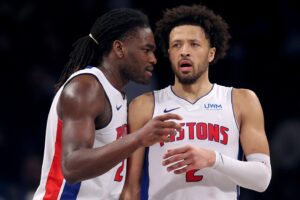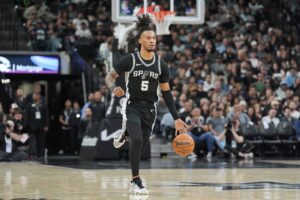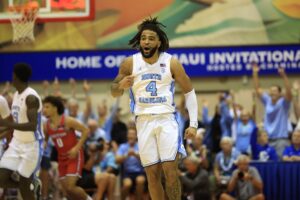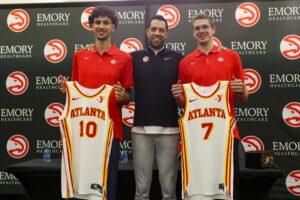Central: Home of the Champs
Sports fans in Cleveland were able to simultaneously celebrate and take a deep sigh of relief after winning the NBA championship in June.
A 52-year title drought across all major professional sports was over. And the crippling weight of local expectations on LeBron James to lead the city out of its athletic wilderness, which dated back to his junior year of high school in Akron, was lifted as he wept on the Oracle Arena floor. A team that won just 57 games during the 2015-16 regular season, endured a coaching change at its halfway point and struggled all throughout to find cohesiveness overcame a historically-great opponent in the Golden State Warriors; and a historically-daunting 3-1 series deficit to do so.
For most of the season, the Cavaliers faced questions over their conditioning, Kevin Love’s overall role on the team, Kyrie Irving’s recovery from a broken kneecap, James’ Twitter habits, and whether the league’s highest payroll would be enough to finish the job started the season before. They ultimately removed all doubts, starting with their second straight Central Division title. Fifty-seven wins turned out to be a full 12 games better than second-place Indiana, and 24 ahead of last place Milwaukee.
Looking Ahead
With nearly the entire roster returning, the Cavs are the odds-on favorite to maintain their spot atop the Central, as well as the Eastern Conference. But the rest of the division gained valuable experience and made meaningful off-season moves. Its multitude of young, up-and-coming players will make the Central the most competitive division in the East. Keep in mind; at the end of last season, second and fourth place were separated by only three games. The Central also came close to making up half of the East playoff bracket.
2015-16 Central Division Standings
Cleveland*^ 57-25 – GB
Indiana* 45-37 12.0
Detroit* 44-38 13.0
Chicago 42-40 15.0
Milwaukee 33-49 24.0
*–made playoffs
^–won NBA title
2016-17 NBA Central Division Preview
(In order of last season’s finish)
Cleveland Cavaliers
Key additions: G/F Mike Dunleavy, C Chris Andersen, PG Kay Felder.
Key losses: PG Matthew Dellavedova, C Timofey Mozgov.
There’s still a lot to like about this team as it attempts to make a third straight trip to the Finals.
Head coach Tyronn Lue will have a full training camp and regular season to continue working with the roster, which struggled to come together until after his promotion. A February deadline trade for backup big Channing Frye also helped bridge the gap between conflicting personalities. James, who averaged 25.3 points, 7.4 rebounds and 6.8 assists, will no longer have to worry about the weight of Northeast Ohio’s title hopes. He also signed a three-year, $100 million contract extension that will keep him around until after his prime (presumably) ends. Love and backup guard Iman Shumpert enjoyed surgery-free off-seasons and should be better-rested than they were a year ago. Irving will have the momentum of winning an Olympic gold medal to carry with him into the new season. The core of the roster will remain as strong as any in the league, and will be buoyed by a supporting cast that has played extensively in pressure playoff environments and knows where it fits in.
Any lingering questions about this team will start with two-guard J.R. Smith, a free agent who has still not re-signed, but could sooner than later. Veteran acquisitions Andersen (free agent) and Dunleavy (trade with Chicago) will provide rebounding and shooting off the bench, respectively, but each has played 14 years in the league and may not have much left in the tank. Though he showed promise throughout the summer, rookie point guard Kay Felder has yet to play a meaningful NBA minute. He projects as Irving’s backup and will be expected to help fill the void left by the hard-nosed Dellavedova, who earned a $38 million pay day from Milwaukee after quietly turning in his best pro season. Mo Williams’ decision to retire last week could create a serious depth issue at the point if Felder is unable to maximize his minutes.
The Cavs will feature a veteran roster that should be able to guard against a championship hangover. Frye, forward Richard Jefferson, center Tristan Thompson and highly-respected guard James Jones are all back for another go-round. Lue and his coaching staff, which could soon feature recent retiree Kevin Garnett, have the attention of the players and will make sure guys aren’t over-worked. The team understands the pace it needs to play at and how to move the ball to create great shooting looks from merely good shooting looks. And, as long as they’re healthy, James and Irving can still dominate a game at the offensive end when called upon. This team will still shoot a ton of 3-pointers and generate a ton of possessions. If James, Love and Irving can remain relatively healthy, the Cavs could win 60 games this season. But make no mistake, the team’s focus is on being prepared for the postseason, even if that means resting players or not playing their best every night during the regular season.
Indiana Pacers
Key additions: PG Jeff Teague, C Al Jefferson, F Thaddeus Young, PG Aaron Brooks, HC Nate McMillan.
Key losses: PG George Hill, C Jordan Hill, PG Ty Lawson, SF Solomon Hill, C Ian Mahinmi, HC Frank Vogel.
Team president Larry Bird has made no secret about his desire to see the Pacers play a faster-paced style of offense and generate more possessions. An off-season loaded with roster changes and a new head coach may finally reach those goals.
Frank Vogel led the Pacers to multiple seasons of 50-plus wins and reached two conference finals during his tenure. But that roster, with a loaded starting lineup and an uninspiring bench unit, was never able to get past the Miami Heat, and was broken up following the 2013-14 season. Star forward Paul George’s broken leg during a Team USA practice in the summer of ’14 further delayed Bird’s vision and led Vogel to work with a cast of pieces and parts that didn’t exactly fit. There was talent enough to reach the playoffs last season, and the seventh-seeded Pacers pushed the second-seeded Toronto Raptors to seven games in the first round. Unfortunately, it wasn’t enough to save Vogel, who was let go and replaced by Nate McMillan.
Then things got exciting. Bird traded for Atlanta point guard Jeff Teague, sending George Hill to Utah in the process. He swung another deal that landed do-it-all power forward Thaddeus Young from Brooklyn. He also managed to sign veteran free agent center Al Jefferson in July. If the goal was to score more points, the Pacers certainly appear to have the right team to do it.
Teague played through injuries all season but still averaged 15.7 points and 5.9 assists for the Hawks. He will be an upgrade over Hill, who could be viewed as a “Three and D” point guard. Teague can get to the basket, shoot from distance and set up his teammates while not slipping much on the defensive end. In short, he’s a very well-rounded player. Young averaged 15.1 points and 9.0 rebounds for the Nets last year and, though undersized as a 6-foot-8 power forward, can make an impact at both ends. Brooks, Jefferson, C.J. Miles, Rodney Stuckey and Lavoy Allen will give the team bench depth it hasn’t had since the days of Reggie Miller.
But there are still questions surrounding the Pacers as they try to make a dent in Cleveland’s division lead. First, where do Jefferson and returning shooting guard Monta Ellis fit in? Both players are strong scorers, but neither exactly fits the Pacers’ desired style of playing through George and Teague. Ellis is projected to start at the two, but how many shots can he realistically expect while sharing the court with Teague, George, Young and second-year center Myles Turner? It could get uncomfortable. Will Jefferson, whose game is predicated on catching the ball in the low post and grinding his way to a shot, be able to mesh with the likes of Young and Turner? Can the team crank up its offensive output while maintaining the league’s third-best defensive rating from a year ago (102.9)?
So much of the team’s success could come down to the progression of George, who helped the U.S. win a gold medal at the Olympics, and averaged 23 points and seven rebounds last season. If he rises to an MVP level and Turner continues to blossom as one of the league’s best young big men, the Pacers could reach or surpass 50 wins again.
Detroit Pistons
Key additions: G Ish Smith, C Boban Marjanovic, PF Jon Leuer.
Key losses: PG Steve Blake, SG Jodie Meeks.
The young Pistons are climbing the Eastern Conference and will have a level of continuity numerous other teams won’t entering the new season.
Head coach Stan Van Gundy has built the Pistons in a similar way to his old Orlando Magic teams: Surround a dominant big man (Dwight Howard, Andre Drummond) with long, rangy wing players. In Orlando, Van Gundy had big guards and forwards that could also make 3-pointers at a high rate and rode that philosophy to a Finals appearance in 2009. While his current roster in Detroit has an abundance of youth, size and toughness, the shooting is still a work in progress. Its 102 points per game last season ranked 19th of 30 teams, and its 34.5 percent shooting from beyond the arc was also 19th.
Van Gundy managed to add some shooting this off-season in the form of backup guard Ish Smith, but will mostly rely on his existing players to simply get better. Guards Reggie Jackson and Kentavious Caldwell-Pope and forwards Stanley Johnson, Marcus Morris and Tobias Harris all have five or fewer years of NBA experience and have room to improve on their shooting. If they do, Drummond (16.2 points, 14.8 rebounds) should continue to own the paint with little resistance. His 66 double-doubles led the league last season.
The league’s 12th-ranked defense in points allowed should improve with the core of the roster staying intact, and the additions of Marjanovich and Leuer will add toughness and rim protection to help out Drummond and Aron Baynes.
With Smith as their most tenured player (six seasons), the Pistons have remained young and should be hungry entering the season. As an eight-seed in last year’s playoffs, they gave the Cavaliers fits at times before losing in four games in the first round. With better outside shooting, there’s no reason to doubt the Pistons’ ability to win as many as 50 games.
Chicago Bulls
Key additions: SG Dwyane Wade, PG Rajon Rondo, C Robin Lopez, G Isaiah Canaan, G Denzel Valentine.
Key losses: PG Derrick Rose, PF/C Joakim Noah, C Pau Gasol, PG Aaron Brooks, G/F Mike Dunleavy.
To say the Bulls underachieved under first-year head coach Fred Hoiberg would be an understatement. On the way to a disappointing 42-40 record that included missing the playoffs, their 101.6 points per game ranked 21st in the league and their 103.1 points allowed ranked 16th.
Hoiberg, brought in to install a sleeker, more potent offense after the firing of defensive wizard Tom Thibodeau, didn’t get much more out of the players at that end; their Pace of 95.7 was 15th in the league. It jumped from 23rd the year before, but was still below what was expected. Mix in the lack of cohesiveness between starting guards Derrick Rose and Jimmy Butler and injuries leading to just three players appearing in more than 69 games and you have a recipe for mediocrity and malaise in the Second City.
Next came the summer shakeup. Rose and Noah, long the backbone of the team, will now play for the New York Knicks. Gasol, an All-Star last season, will play for the San Antonio Spurs. Brooks and Dunleavy stayed in the Central but will play for the Pacers and Cavaliers, respectively. Butler will enter this season as Hoiberg’s de facto leader at both ends. Luckily, he has a future hall-of-famer to help him in free agent signee Dwyane Wade.
The Wade signing came as a major surprise, as it was assumed he’d wear a Miami Heat uniform until his retirement. But the 34-year-old opted to come to his hometown on a two-year, $47 million contract. The Bulls also signed free agent point guard Rajon Rondo to initiate Hoiberg’s offense. Center Robin Lopez came over in the Rose trade with New York. The returning Taj Gibson will likely open the season as the team’s starting power forward. Off the bench, newcomers Isaiah Canaan and Denzel Valentine will join holdovers Tony Snell, Nikola Mirotic, Bobby Portis and Doug McDermott to form a puzzling rotation with major boom-or-bust potential.
Questions abound with this group. Rondo averaged 11.9 points, 11.7 assists and 6.0 rebounds for Sacramento last season, but how will he mesh with the ball-dominant Wade? And will they both be able to stay off the injured list for most of the season? Neither player has surpassed 70 games played more than once in the past four seasons. Will Rondo and Wade stall the growth of Butler’s all-around game? The two-time All-Star reached career highs in points (20.9) and rebounds (5.3) last season. Beyond Butler and Lopez, will defensive effort be consistent? Wade’s injury history won’t allow him to go full bore every night, Rondo’s focus has been known to wane at times, Gibson is undersized for his position at 6-foot-9, and reserves like Mirotic and McDermott are pure shooters. Butler’s continued improvement and the ability of Rondo and Wade to share the ball and remain healthy will go a long way toward helping the Bulls take steps forward.
If this mix-and-match roster can figure out a balance, it could approach last year’s 42-win total, but no higher.
Milwaukee Bucks
Key additions: PG Matthew Dellavedova, F Thon Maker, F Mirza Teletovic, G Jason Terry.
Key losses: G Jerryd Bayless, PG Greivis Vasquez, SG O.J. Mayo, PG Tyler Ennis.
The Bucks will head into this season as one of the NBA’s most intriguing young teams. A playoff appearance in 2015 was followed by regression and a 39-win 2016 that resulted in a last place finish in the Central Division, but much of the talented roster remains, and should be better with another year of experience under the tutelage of Jason Kidd.
Any improvement in the Bucks will start with guard-forward Giannis Antetokounmpo, who finished last season with career highs in points (16.9), rebounds (7.7), assists (4.3), steals (1.9), blocks (1.4) minutes (35.3) and field goal percentage (50.6). The 6-foot-11 swiss army knife from Greece has the size and quickness to play up to four positions, but could be transitioning into Kidd’s permanent starting point guard. Holdovers Michael Carter-Williams, Jabari Parker, Greg Monroe and John Henson will provide scoring inside of 20 feet and the length and athleticism to make scoring tough on most opponents.
The league’s 17th-ranked defense in points allowed (103.2) should improve with the addition of Dellavedova, and the 7-foot-1 Maker is another player in the Antetokounmpo mold who could potentially play multiple positions.
But where will points come from? The Bucks were positively anemic at times offensively last year, scoring 99.0 points per game (25th in the NBA), though their 46.7 percent shooting from the field actually ranked fifth in the league. The second-biggest question facing the team is how it will cope with the loss of guard Khris Middleton, who will miss around six months after rupturing a hamstring during a workout Sept. 20. Middleton played just over 36 minutes per game for the Bucks last season, and led the team in scoring with 18.2 points. With the loss of Bayless, Middleton would’ve been the team’s highest-rated returning three-point shooter (39 percent last year). Teletovic (39.3 percent on threes), Terry (35.6) and Dellavedova (41.0) could certainly help in that department, though all are fairly one-dimensional in their scoring ability, while Middleton was more dynamic.
If the young Bucks can fix their scoring issues, weather the loss of Middleton and get another improved season out of Antetokuonmpo, they could easily climb out of the Central basement and win between 41-45 games, challenging for a low playoff seed. This team has plenty of talent, but it hasn’t yet matured into a contender.






